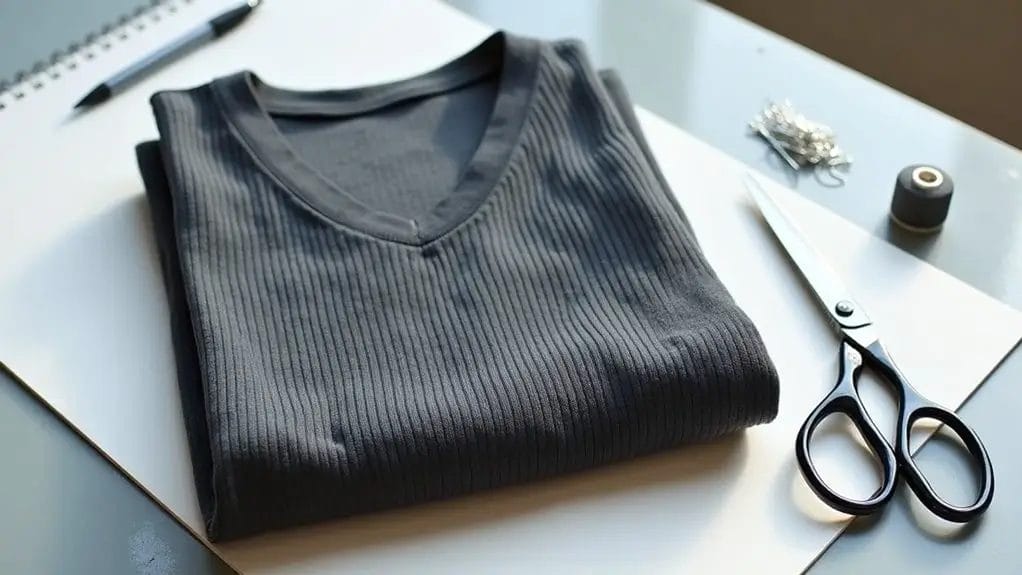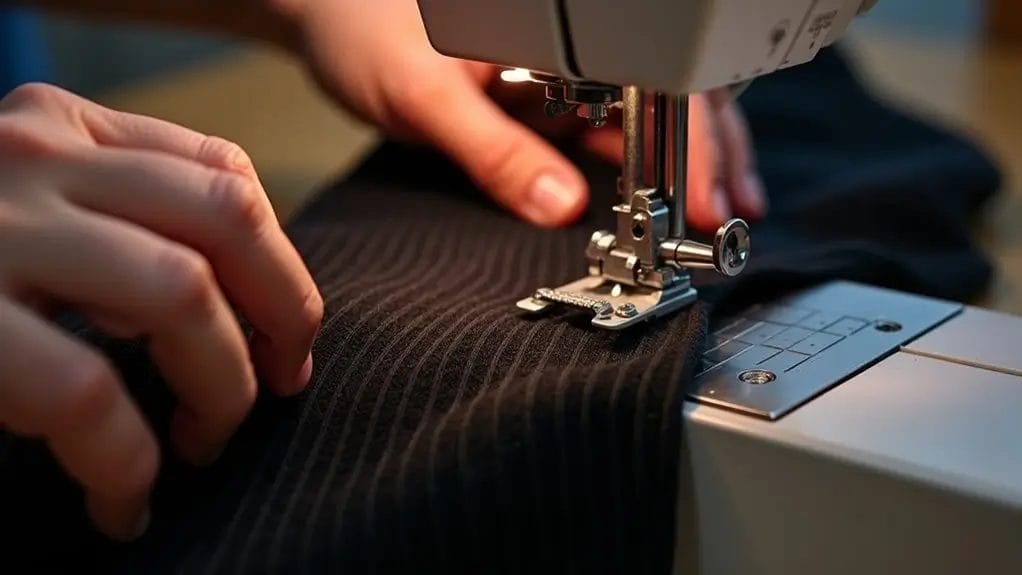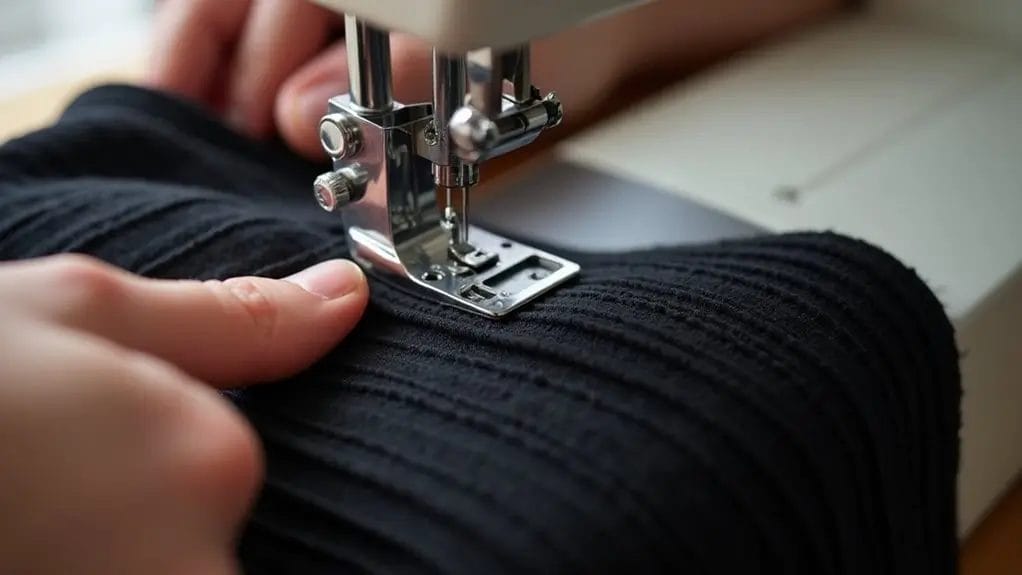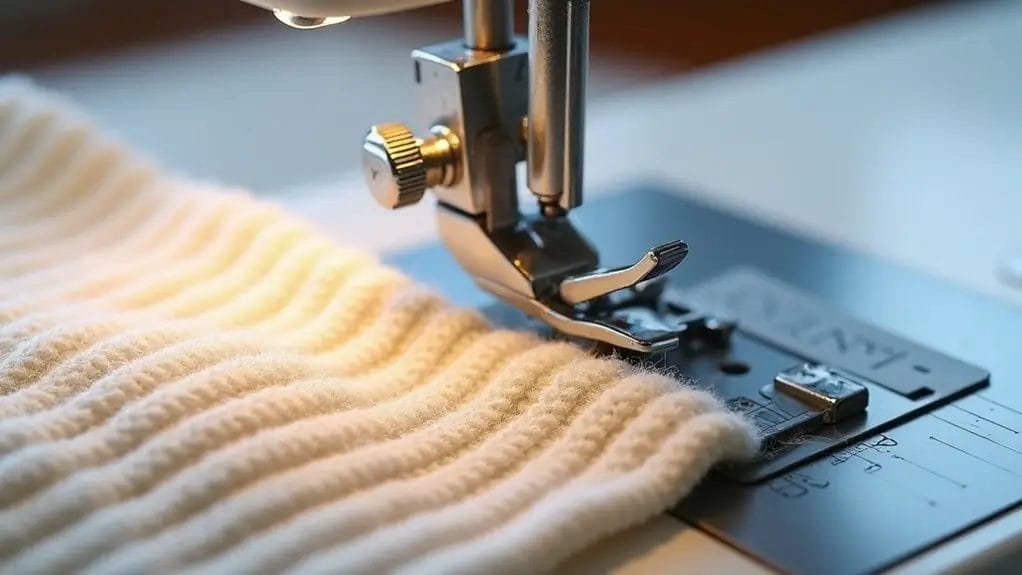If you've ever struggled with sewing stretchy fabrics, rib knit can seem particularly intimidating. This versatile material, known for its distinctive ribbed texture and excellent stretch recovery, requires specific techniques to handle properly. While it's true that working with rib knit presents unique challenges, you don't need to be an expert seamstress to achieve professional results. With the right tools and approach, you'll master this fabric and access countless creative possibilities.
Key Takeaways
- Select a quality rib knit fabric with good recovery and stretch, testing samples before starting your project.
- Use ballpoint or stretch needles with polyester thread and set your machine to a longer stitch length (2.5-3.0mm).
- Cut fabric carefully along the stretch direction, following the grainline and using fabric weights for stability.
- Choose appropriate stitches like narrow zigzag or lightning stitch to maintain fabric stretch during sewing.
- Adjust presser foot pressure to medium-light and maintain even pressure while sewing to prevent stretching and distortion.
Preparing to Sew with Rib Knit

When selecting a rib knit fabric, you'll want to choose a quality material with good recovery and stretch that matches your project's needs - whether it's cuffs, neckbands, or entire garments.
You'll need specific tools for working with rib knit, including ballpoint or stretch needles, polyester thread, and a walking foot for your sewing machine. A rotary cutter, self-healing mat, and pattern weights will also help you accurately cut this stretchy fabric without distortion.
Choosing the Right Rib Knit Fabric
Before starting your rib knit project, selecting the right fabric is essential for achieving professional results.
Choose a rib knit fabric with good stretch and recovery properties - it should bounce back to its original shape after being stretched.
Consider the weight carefully; lighter-weight ribs work well for t-shirts and underwear, while heavier versions suit sweaters and cuffs.
Check the fiber content and blend ratios.
Cotton-spandex blends offer comfort and stability, typically containing 95% cotton and 5% spandex. The higher the spandex content, the more stretch you'll get.
Test the fabric's recovery by stretching a sample and observing how it returns to shape.
Essential Tools and Supplies for Sewing with Rib
Successful rib knit sewing requires a specialized set of tools and supplies to handle this stretchy material.
You'll need a regular sewing machine or serger, though a coverstitch machine is ideal for professional-looking hems. Always use ballpoint or stretch needles to prevent damaging your fabric's fibers.
Keep elastic handy for stabilizing seams and creating secure bands. Before starting, test your fabric's stretch percentage to determine the best stitch settings.
Essential supplies include:
- Stretch or ballpoint needles (size 70/10 or 80/12)
- Polyester thread
- Walking foot attachment
- Clear elastic
- Stretch gauge
- Sharp fabric scissors
Techniques for Sewing with Rib Knit

You'll want to set your sewing machine with a longer stitch length and reduced presser foot pressure to accommodate rib knit's natural stretch.
When cutting your fabric, use sharp scissors or a rotary cutter and maintain steady, even pressure to prevent distortion and stretching at the edges.
For construction, you can choose between a zigzag stitch, triple stretch stitch, or serger/overlock stitch, depending on the seam type and amount of stretch needed.
Best Sewing Machine Settings for Rib Knits
Proper machine settings are essential for working with rib knit fabric.
When you sew stretchy knit fabric, you'll need specific adjustments to maintain the material's stretch and recovery properties. Your stitch selection and tension settings directly impact how well your seams hold up in the finished garment.
- Set stitch length to 2.5-3.0mm and use a ballpoint needle size 70/10 or 80/12.
- Adjust presser foot pressure to medium-light to prevent stretching as you sew.
- Select either a narrow zigzag stitch (width 0.5-1.0) or a specialized stretch stitch.
Test these settings on fabric scraps before sewing your main project to ascertain proper stitch formation and seam durability.
Stitch Types for Sewing Rib Knit Fabric
Building on your machine settings, specific stitch types make a significant difference when working with rib knit fabric.
When sewing with rib, you'll notice alternating knit and purl stitches create distinctive vertical lines. Choose stitches that complement these patterns, running either lengthwise or crosswise along the fabric's grain.
For seams, use a narrow zigzag or lightning stitch to maintain stretch. The lightning stitch particularly suits rib knit as it follows the natural pattern of knit stitches while providing durability.
For hems and edges, consider using a twin needle to create parallel rows that mirror the fabric's ribbed texture.
Tips for Cutting and Handling Rib Knits
Since rib knit fabric tends to curl at the edges, cutting and handling require specific preparation techniques. Before cutting your stretchy rib knits, measure both the width and circumference to understand the fabric's texture and recovery properties.
- Always place your pattern pieces following the grainline, and cut on a flat surface with weights to prevent shifting.
- Test a small sample first to determine how the fabric behaves when stretched.
- Account for the fabric's natural contraction by measuring the relaxed width versus stretched width.
These steps guarantee accurate cutting and proper handling of your rib knits for successful garment construction.
How to Sew with Rib Knit Fabric

You'll need to follow four key steps to successfully sew with rib knit fabric: prepare your fabric by pre-washing and laying it flat, cut your pattern pieces with careful attention to the stretch direction, sew your seams using a stretch or zigzag stitch, and finish your edges with appropriate techniques like double-folded bands or coverstitch.
To get professional results, you should always test your stitches on scraps first and adjust your machine's tension and presser foot pressure.
Your finished project will look best when you press seams gently and handle the fabric with care throughout the sewing process.
Step 1: Preparing the Fabric
Before working with rib knit fabric, prepare it properly by washing and drying according to the care instructions on the bolt or label. This versatile, stretchy material requires careful handling before you get sewing.
- Identify the right side and wrong side of your rib knit fabric by examining the vertical ribs - they'll be more prominent on the right side.
- Check the fabric's drape and stretch direction to determine the best layout for your pattern pieces.
- Make sure all your pattern pieces are aligned in the same direction for proper matching and consistent stretch.
Remember to pre-shrink your fabric to prevent size changes after garment completion.
Step 2: Cutting the Pieces
Cutting rib knit fabric requires specific techniques to guarantee accurate pieces and maintain the fabric's stretch properties.
Lay your rib fabric flat, ensuring the stretch direction runs parallel to the width for bodice pieces and lengthwise for cuffs. If you're working with tubular rib knit, cut along the fold to create separate pieces.
Use sharp scissors or a rotary cutter to slice through single layers rather than folded jersey.
When cutting cuffs or neckbands, measure the stretch percentage first and cut pieces shorter than the final measurement.
For tube-style pieces like sleeve cuffs, cut perpendicular to the maximum stretch direction.
Step 3: Sewing the Seams
Now that your pieces are properly cut, let's focus on the seam construction. When you sew with rib knit, proper seam techniques prevent gaping and guarantee durability. Use a ballpoint needle and stretch stitch for best results.
- Start with shoulder seams, sewing from neck to arm, maintaining even tension to avoid rippling.
- Attach neckband by stretching slightly while sewing, creating a snug fit that won't gap.
- Apply the same technique for sleeve cuffs and waistband, stretching the one knit piece as you hem.
Remember to test your stitches on scraps first, adjusting tension and stitch length as needed.
Step 4: Finishing Touches
The final steps of working with rib knit require careful attention to verify a professional finish.
When adding neckbands and cuffs, use a slightly heavier cotton rib or polyester blend for better structure. Measure your neckline carefully and cut the band about 15% shorter than the opening. Pin the band evenly around the neckline, stretching it slightly as you sew.
For sweater cuffs, fold the fabric double and stitch with a stretch stitch. Press all seams gently with low heat, being careful not to over-stretch the fabric.
Test the stretch of your finished bands to verify comfort and durability.
Troubleshooting Common Issues

When sewing with rib knits, you'll likely encounter common challenges like wavy seams, stretched edges, or skipped stitches.
You can overcome these issues by adjusting your stitch length, using proper stabilization techniques, and maintaining even pressure while guiding the fabric.
Using the right needle type and size, along with proper tension settings, will help you achieve professional-looking results with rib knit fabrics.
Common Problems When Sewing Rib Knits
Despite being a versatile material, rib knit fabric can present several challenging issues during the sewing process. This commonly used fabric, often very stretchy and featuring alternating knit and purl stitches that create a distinctive ridge pattern, requires special handling - especially when working with wool or rayon blends.
- Fabric curling at edges, particularly when creating neckbands and cuffs, making alignment difficult.
- Uneven stretching during stitching, causing wavy seams and distorted rib cuff applications.
- Thread tension problems leading to skipped stitches or seam puckering, especially noticeable along the one purl stitch pattern.
Solutions for a Smooth Sewing Experience
Successfully managing rib knit challenges requires specific techniques and the right tools.
When making a dress or tee, use a walking foot to prevent layers from shifting and stretching. For lighter rib knits, install a new ballpoint needle and reduce presser foot pressure.
If rib knits often bunch up while sewing tank tops, place tissue paper underneath the fabric as you stitch.
Keep seams short and stable by using clips instead of pins.
When you want to use rib knits for neckbands, cut them 15% shorter than the opening measurement for proper stretch recovery.
Frequently Asked Questions
Can I Use Regular Thread for Sewing Rib Knit Fabric?
You'll need polyester thread or wooly nylon thread for rib knit fabric. Don't use regular cotton thread as it'll break when the fabric stretches and won't provide enough flexibility.
How Long Will Rib Knit Fabric Last Before It Loses Elasticity?
Your rib knit fabric will maintain elasticity for 1-2 years with regular wear, but you'll extend its life by washing in cold water and avoiding high heat drying.
Is Rib Knit Fabric More Expensive Than Regular Knit Fabrics?
You'll typically pay 15-30% more for rib knit fabric compared to regular knits, due to its specialized construction and higher yarn content that creates those distinctive vertical ribs.
Can I Mix Rib Knit With Woven Fabrics in the Same Project?
You can mix rib knit with woven fabrics, but you'll need to stabilize the seams and account for different stretch properties. Consider using interfacing or stabilizer where they join.
Does Rib Knit Fabric Shrink More Than Other Knit Fabrics?
Yes, you'll typically find that rib knit shrinks more than other knits. Pre-wash your fabric in hot water and dry it on high heat to prevent unwanted shrinkage in your finished garment.
Conclusion
Now that you're equipped with the essential knowledge of working with rib knit fabric, you'll find it's a versatile material that's worth mastering. Remember to maintain proper tension, use the right needles and stitches, and always test your settings before starting your project. With practice and patience, you'll create professional-looking garments that showcase rib knit's unique stretch and recovery properties.


0 comments